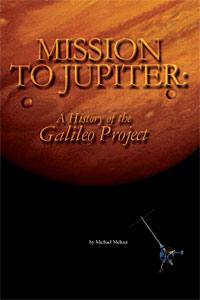Review: Mission to Jupiterby Taylor Dinerman
|
| In spite of a dry and understated tone, inevitable when writing an official history of this kind, Michael Meltzer manages to convey the real excitement and sense of wonder that all, or almost all, of those involved in the project must have felt. |
After its encounter with Venus in February 1990 and its first Earth flyby in December of that year, Galileo flew out into the asteroid belt where it encountered Gaspra in October 1991, sending back some extraordinary images. Its final encounter with Earth was in December 1992. In August 1993 it flew within 2,400 kilometers of the asteroid Ida, discovering a small moon, Dactyl. This was the first of many surprising discoveries that would emerge over the years from the program.
The greatest long-term challenge to the mission was the failure of the High Gain Antenna (HGA) to fully deploy. The mission team was able to find ways of using the Low Gain Antenna to compensate for the loss of the HGA. The first software fix was radioed to Galileo in March 1995. Later software improvements were able to insure that the mission achieved all of its objectives and more. This success in fixing a damaged probe in deep space have given NASA space scientists and engineers a reputation for can-do excellence that has survived even the loss of a pair of Mars missions.
Galileo arrived in orbit around Jupiter in December 1995. The atmospheric probe entered the planet’s atmosphere and for 61 minutes sent back a treasure trove of data that now provides a new basis on which astronomers can build their theories about the formation of solar systems and gas giants. The rest of the spacecraft would spend the next two years carrying out its prime orbital tour, which would repeatedly carry it past three of the major Galilean moons, Ganymede, Callisto, and Europa.
After this, it would carry out flybys of the mysterious Io and of Europa, where there were signs of a possible subsurface ocean. Operations continued until the final demise of the craft in September 2003. Working inside Jupiter’s intense radiation belts with a spacecraft whose technology may have been cutting edge in the early 1980s—at a time of 16-bit microprocessors and dot matrix printers—the team’s ability to extract the “last full measure of devotion” from the distant robot stands as a tribute to the skill and devotion of all involved.
In spite of a dry and understated tone, inevitable when writing an official history of this kind, Michael Meltzer manages to convey the real excitement and sense of wonder that all, or almost all, of those involved in the project must have felt. This book will stand the test of time, not only as a history of the project but also as a record of the accomplishments of an exceptional group. The personnel and leadership may have changed over the years, but the team spirit of the project’s individual members remained alive in spite of all the difficulties.
In the end, despite the problems with the HGA and later with the data recorder, Galileo was a model for what a successful large-scale deep space probe program should be. Today’s Cassini spacecraft orbiting around Saturn owes a lot to its predecessor. As NASA begins work on its next flagship planetary mission, which may in fact be a trip to Jupiter to take up where Galileo left off, space industry leaders should not only keep in mind the technical lessons of this project, but the human and political ones as well. Above all they should remember that nothing worthwhile is ever easy.
